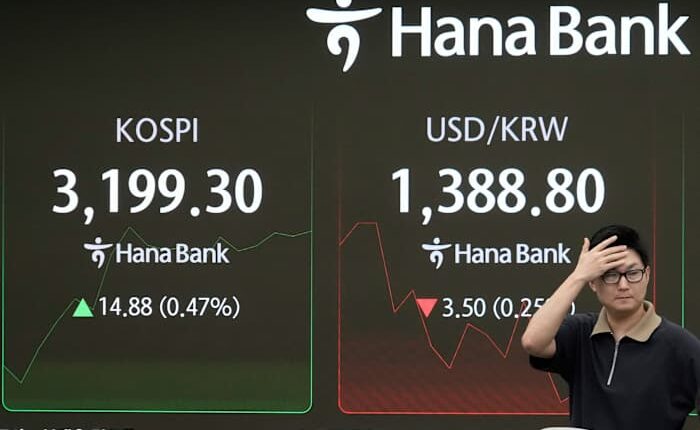Share this @internewscast.com

MANILA – Asian stock markets generally saw gains on Thursday, buoyed by a surge in technology stocks that helped stabilize Wall Street. A dip in the dollar further enhanced the appeal of Asian investments.
U.S. futures were mixed while oil prices were lower.
Japan’s Nikkei 225 saw an increase of 1.2% to hit 42,437.37, while Australia’s S&P/ASX 200 rose 0.6% to 8,791.50. South Korea’s Kospi was up by 0.2% to reach 3,192.22. Taiwan’s market gained 0.7%, and India’s BSE Sensex also advanced by 0.6%.
However, not all Asian markets followed this positive trend. Hong Kong’s Hang Seng index declined by 1.1% to 25,006.22, and the Shanghai Composite index dropped nearly 2% to 3,738.32, amid concerns about possible regulatory intervention due to high stock increases and liquidity issues.
On Wednesday, Wall Street found stability as Alphabet and other tech firms rallied. The U.S. bond market saw less pressure after a disappointing job market report raised hopes that the Federal Reserve might soon cut interest rates to boost the economy.
The S&P 500 rose by 0.5%, ending a two-day losing streak after reaching a new record. Meanwhile, the Dow Jones Industrial Average fell by 24 points, or 0.1%, and the Nasdaq composite increased by 1%.
Alphabet, Google’s parent company, was a significant contributor to the market’s rise, soaring 9.1% after sidestepping some of the most severe outcomes in its antitrust case.
Also helping to steady Wall Street was a calming bond market. A day earlier, yields climbed worldwide on worries about governments’ abilities to repay their growing mountains of debt, as well as concerns that President Donald Trump’s pressure on the Federal Reserve to cut short-term interest rates could lead to higher inflation in the long term.
Such worries have pushed investors to demand higher yields before lending money to governments. And when bonds are paying more in interest, investors feel less need to pay high prices for stocks, which are riskier investments.
On Wednesday, Treasury yields retreated following the latest report on the U.S. job market to come in weaker than expected. The 10-year Treasury yield fell to 4.22% from 4.28% late Tuesday, for example.
The report showed that U.S. employers were advertising 7.2 million job openings at the end of July, fewer than economists had forecast.
A weakened job market could push the Federal Reserve to cut its main interest rate for the first time this year at its meeting later this month. That’s the widespread expectation among traders, with the next big data point coming on Friday via an update on U.S. hiring during August.
Lower interest rates could give the job market and overall economy a boost. The downside is that they can also push inflation higher when Trump’s tariffs may be set to raise prices for all kinds of imports.
“The dollar, naturally, buckled under the weight of weaker jobs and lower rates, and increased Fed cut bets, handing Asia an early boost. When the U.S. dollar slides, Asian assets instantly look more attractive in currency-adjusted terms, and regional equities should snap to life after a sluggish start to September,” Stephen Innes of SPI Asset Management said in a commentary.
But he said Chinese equities slid as regulators fret over excessive stock gains and too much liquidity in the system, with Beijing signaling it may tighten the screws.
In other dealings on Thursday, U.S. benchmark crude lost 42 cents to $63.55 per barrel. Brent crude, the international standard, shed 35 cents to $67.25 per barrel.
The U.S. dollar rose to 148.24 Japanese yen, from 148.05 yen. The euro fell to $1.1653 from $1.1667.
Copyright 2025 The Associated Press. All rights reserved. This material may not be published, broadcast, rewritten or redistributed without permission.













